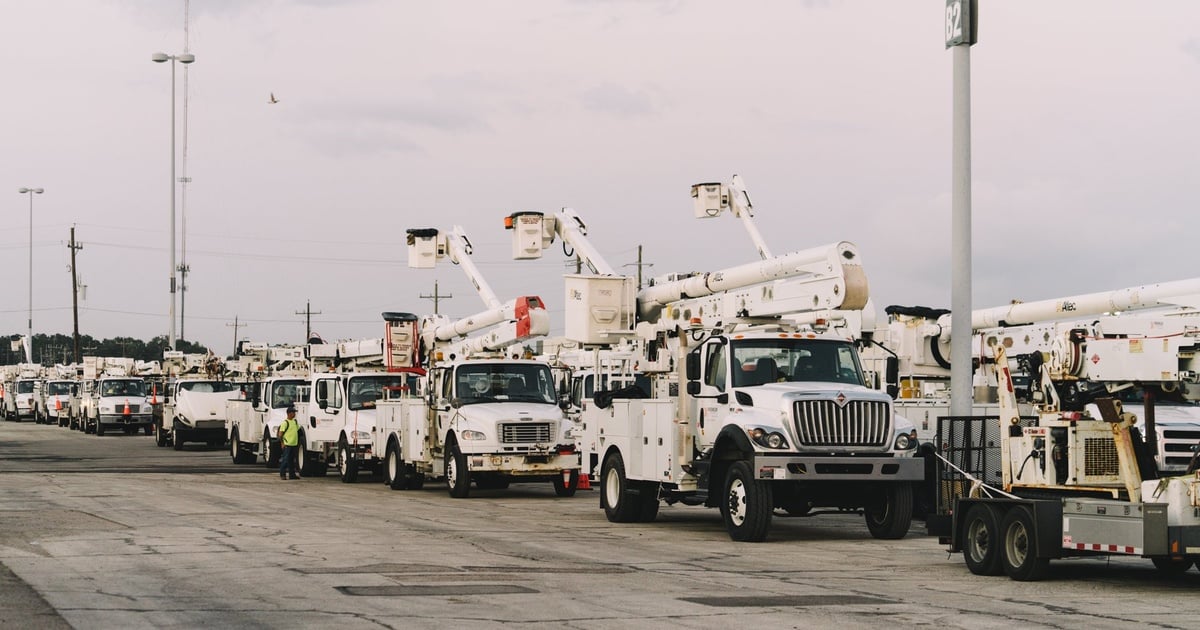Sign up for The Brief, The Texas Tribune’s daily newsletter that keeps readers up to speed on the most essential Texas news.
HOUSTON — Erick Trice knows the routine of a disaster. The 55-year-old lineman packs his clothes. Maybe he spends a little more time with his two adult sons before leaving. “Go make that money,” his wife says. He drives away from his hometown of Evansville, Indiana, in his bucket truck.
As a lineman, Trice has worked three ice storms and two tornadoes, repairing electric infrastructure and getting power flowing again. When he got the call to help around Houston after Hurricane Beryl’s fierce winds knocked the system into disarray, he said yes. Most people do, he said. Only something like a wedding might get in the way.
“We love to go get people’s power back on,” Trice said.
Trice is among thousands of linemen working across southeast Texas after wind, tree branches and, in some cases, entire trees took down lines and poles. Trice works as an employee for CenterPoint, the Houston-area utility company that had more than 2 million customers lose power after the hurricane.
The electric infrastructure’s failure to withstand the storm left Texans seething. Residents tossed spoiled food and slept in cars to try to stay safe without power in dangerous heat. CenterPoint struggled to communicate when power would return. A graffiti artist scrawled “CenterPointle$$” on a roadway. Someone posed skeletons next to a sign reading, “Waiting on CenterPoint,” a Houston Chronicle photograph showed.
The utility is responsible for taking care of the poles and lines that deliver power in the area and now faces serious questions: Did CenterPoint trim trees properly? Did it maintain and bulk up its equipment as it should have? Many here think not. The CEO in an interview with the Chronicle defended the system as working as designed. State regulators promised a full review.
The sheer size of the failure exposed a scary truth: Electric infrastructure here is vulnerable to storms that are likely to be stronger due to climate change, and it will cost a lot of money to make the system tough enough to withstand them. That leaves residents at risk and puts the responsibility of recovery — and even saving lives — on utility officials and linemen like Trice.
Trice liked electrical work since he was a kid. His uncle was an electrician and sometimes took him along as he worked in homes. He started as a groundman, memorizing the tools so he could pass them to linemen. He learned to climb poles and went through an apprenticeship program that taught him how to handle dangerous wires.
That’s why we want to hear your thoughts about how we use artificial intelligence in our work.
With 31 years in the industry, Trice drove the roughly 850 miles to Texas on Tuesday. Or so he thinks — the days are blurring together. Since he got here, he’s been reporting for duty at 6 a.m. at the Sam Houston Race Park, where he eats a hot breakfast and gets his instructions. He takes maybe a 20-minute break for lunch and eats dinner when he gets off the 16-hour shift. He keeps working even if he’s tired, knowing he’ll rest at the end of this, perhaps in two weeks.
“We’re in storm mode, and we just keep going,” Trice said. “You get in that hotel, you take a shower and you pass out, and your alarm clock wakes you up, and you get back up and go.”
On Saturday, he worked on replacing two poles that broke around the northwest part of the city. He and his team had to unclip wires from the poles, pull out the old poles and put new ones in. The process takes time because other workers must find the gas, water and sewer lines to make sure they don’t mess those up.
Power has been restored to 1.8 million CenterPoint customers since the hurricane hit but some 450,000 still lacked power as of Sunday morning, according to the utility.
Linemen have faced the anger of a frustrated community. Earlier in the week, a man allegedly threatened an electric worker with a BB or airsoft gun, according to ABC 13. More than 100 linemen evacuated from a site after shots were allegedly fired at them, CenterPoint President and CEO Jason Wells said in a video posted Saturday.
Trice said people have also thanked them and prayed for them. While driving his truck last week, he felt afraid to look over at a car next to him in case the driver was not happy with his driving. But when he turned, he saw a kid with a sign that said thank you.
Disclosure: Sam Houston Race Park has been a financial supporter of The Texas Tribune, a nonprofit, nonpartisan news organization that is funded in part by donations from members, foundations and corporate sponsors. Financial supporters play no role in the Tribune’s journalism. Find a complete list of them here.
Big news: director and screenwriter Richard Linklater; NPR President and CEO Katherine Maher; U.S. Rep. Pete Aguilar, D-California; and Luci Baines Johnson will take the stage at The Texas Tribune Festival, Sept. 5–7 in downtown Austin. Buy tickets today!

